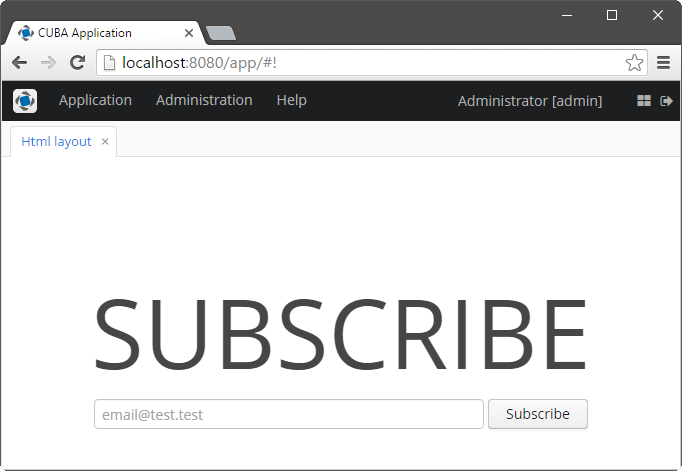5.5.2.2.8. HtmlBoxLayout
HtmlBoxLayout is a container that enables you to define locations of components in an HTML template. The layout template is included in a theme.
XML-name of the component: htmlBox.
Below is an example of using htmlBox for a simple screen.

Screen’s XML-descriptor:
<htmlBox align="TOP_CENTER"
template="sample"
width="500px">
<label id="logo"
value="Subscribe"
stylename="logo"/>
<textField id="email"
width="100%"
inputPrompt="email@test.test"/>
<button id="submit"
width="100%"
invoke="showMessage"
caption="Subscribe"/>
</htmlBox>template attribute defines the name of an HTML file located in the layouts subdirectory of your theme. You should create a theme extension or a custom theme before creating a template. For example, if your theme is Halo and the attribute contains my_template, the template file should be modules/web/themes/halo/layouts/my_template.html.
Content of the HTML template located in the modules/web/themes/halo/layouts/sample.html file:
<div location="logo" class="logo"></div>
<table class="component-container">
<tr>
<td>
<div location="email" class="email"></div>
</td>
<td>
<div location="submit" class="submit"></div>
</td>
</tr>
</table>A template should contain <div> elements with location attributes. This elements will display CUBA components defined in the XML descriptor with corresponding identifiers.
Content of modules/web/themes/halo/halo-ext.scss file (see Extending an Existing Theme for how to create this file):
@import "../halo/halo";
@mixin halo-ext {
@include halo;
.email {
width: 390px;
}
.submit {
width: 100px;
}
.logo {
font-size: 96px;
text-transform: uppercase;
margin-top: 50px;
}
.component-container {
display: inline-block;
vertical-align: top;
width: 100%;
}
}- Attributes of htmlBox
-
align - enable - height - id - stylename - template - visible - width
- API
-
add - getComponent - getComponentNN - getComponents - getOwnComponent - getOwnComponents - remove - removeAll